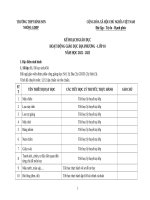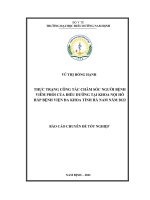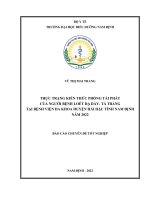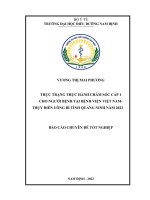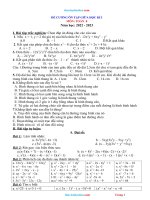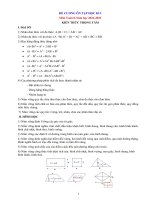Assignment Java Programming (PROG191) Greenwich 2022
Bạn đang xem bản rút gọn của tài liệu. Xem và tải ngay bản đầy đủ của tài liệu tại đây (1.36 MB, 24 trang )
ASSIGNMENT 1 FRONT SHEET
Qualification
BTEC Level 5 HND Diploma in Computing
Unit number and title
Submission date
01/05/2022
Re-submission Date
Date Received 1st submission
Date Received 2nd submission
Student Name
Nguyen Manh Tung
Student ID
GCH200064
Class
GCH0907
Assessor name
Dinh Duc Manh
Student declaration
I certify that the assignment submission is entirely my own work and I fully understand the consequences of plagiarism. I understand that
making a false declaration is a form of malpractice.
Student’s signature
Grading grid
Grade (0-10)
1.1
1
Tung
❒ Summative Feedback:
❒ Resubmission Feedback:
2.1
Grade:
IV Signature:
Assessor Signature:
Date:
2
Contents
I. Introduction ............................................................................................................................................................... 5
II. Requirement ............................................................................................................................................................. 5
III. UI design ................................................................................................................................................................. 6
VI. Implementation ....................................................................................................................................................... 7
1. Program structure.................................................................................................................................................. 8
2. Explain classes ...................................................................................................................................................... 8
3. Explain important algorithms ............................................................................................................................. 10
V. Testing .................................................................................................................................................................... 17
VI. Result ..................................................................................................................................................................... 18
VII. Conclusion ............................................................................................................................................................ 23
3
Figure 1: Login interface ............................................................................................................................................... 6
Figure 2: Sign Up interface............................................................................................................................................ 6
Figure 3: Home page interface ..................................................................................................................................... 7
Figure 4: Flow of system ............................................................................................................................................... 7
Figure 5: Classes ............................................................................................................................................................ 8
Figure 6: LoginModel class............................................................................................................................................ 9
Figure 7: MainModel class ............................................................................................................................................ 9
Figure 8: Login function (part 1) ................................................................................................................................. 10
Figure 9: Login function (part 2) ................................................................................................................................. 10
Figure 10: Signup function .......................................................................................................................................... 11
Figure 11: setAccount function ................................................................................................................................... 11
Figure 12: wirteDataToFile function ........................................................................................................................... 12
Figure 13: Add function .............................................................................................................................................. 12
Figure 14: showAccessory function ............................................................................................................................ 13
Figure 15: updateAccessory function ......................................................................................................................... 13
Figure 16: Edit function............................................................................................................................................... 13
Figure 17: Delete function .......................................................................................................................................... 14
Figure 18: Delete all function...................................................................................................................................... 14
Figure 19: Sort function .............................................................................................................................................. 15
Figure 20: Search function .......................................................................................................................................... 15
Figure 21: LoadData function ..................................................................................................................................... 15
Figure 22: WriteData Function ................................................................................................................................... 16
Figure 23: Error of if/else (part 1) ............................................................................................................................... 17
Figure 24: Error of if/else (part 2) ............................................................................................................................... 17
Figure 25: Error of Exception ...................................................................................................................................... 17
Figure 26: Signup successful ....................................................................................................................................... 19
Figure 27: Login Successful ......................................................................................................................................... 19
Figure 28: Home page ................................................................................................................................................. 20
Figure 29: Insert successful ......................................................................................................................................... 20
Figure 30: Update function ......................................................................................................................................... 21
Figure 31: Confirm of delete ....................................................................................................................................... 21
Figure 32: Delete successful ....................................................................................................................................... 22
Figure 33: Sort by ID from z to a ................................................................................................................................. 22
Figure 34: Search key "a" ............................................................................................................................................ 23
4
I. Introduction
In this assignment, the problem is to develop an application to solve a business problem of auto accessories
management. The problem requires a graphical user interface with features that require reading/writing data
from text files for login and signup functionality, working with data sets (like search). The application must
handle errors so that it does not fail on the end-user side. The application also needs to be fully tested before
the production phase.
Attached is a technical report, it is necessary to write a technical report on the development of the
application. The content of the report includes design, implementation and testing.
II. Requirement
The user is the administrator of the auto accessories management system.
They want to have a registration interface that includes the input data of user name, password, confirm
password and phone number.
After registering, they want the data to be saved to a file with the extension txt.
They want to login successfully when entering pre-registered or pre-existing information.
They want to report an error if the login or registration form is missing information, or the wrong user name
or password is entered.
When accessing the system, some exceptions such as file not found are set if present.
After successful login, the system will display the main interface including functions such as add new, edit,
delete, delete all.
They want some other extra functions such as sorting and searching based on the information of auto
accessories.
The exit button is used to exit the program, the logout button will return to the login interface.
5
III. UI design
Figure 1: Login interface
Figure 2: Sign Up interface
6
Figure 3: Home page interface
VI. Implementation
Figure 4: Flow of system
7
1. Program structure
The user will start with the login interface or the signup interface. With the signup interface, the user will
enter the registration information and register an account, after registration, the information will be saved
to the txt file and navigate to the login page. The user will enter an already registered or pre-registered
account. After successful login, the system will redirect to the main page containing the functions of the car
management system. To perform any function the user has to enter a new product and save it in the table.
With Edit, select the product you want to edit, edit and update the product.
With Delete, select the product you want to delete, click delete to delete the product. With Delete all, there
is no need to select the product.
Select Sort, then click on the column names to sort from a-z or 0-9 or vice versa.
Write the key word you want to find in the search box, the corresponding product will appear automatically.
The user can return to the login interface with the logout button or exit the workflow with the exit button.
2. Explain classes
The system is implemented based on 2 classes type Model.
Figure 5: Classes
The LoginModel.java class is used to set and get data from the input and call it in the View, it is also used
to hash the user name and password.
It has public functions such as constructor (for initialization), set and get functions to retrieve data from
view and tea it back (for storage and use purposes).
There are also a number of other functions such as hash code for encrypting data, applying to passwords
and usernames.
8
Figure 6: LoginModel class
The MainModel.java class has the main function of setting and getting the product's data, storing it for the
Home Page to call out and providing the algorithms.
Figure 7: MainModel class
9
Like LoginModel class, Main Model also has constructor, set, get function to store, use data. Datas is ID,
accessory, category, publisher, cost.
3. Explain important algorithms
a) Login function
At the beginning, the LoadData function will be run to
load the file, providing data for the login algorithm.
Figure 8: Login function (part 1)
A List<> distortion will be initiated to work with LoginModel. The file is also created for writing and reading.
Figure 9: Login function (part 2)
After entering the account into the input cells and clicking login button, the system will retrieve
information from the input, initialize an object of LoginModel, transmit to its constructor login data.
10
If the user name or password is empty, the message will enter enough information to continue. Check if
the data from the txt file has and contains the corresponding login information, open the home page and
close the login interface, if wrong, the error message.
b) Signup with write file
Figure 10: Signup function
When the user clicks on the registration button, the system goes to the corresponding function. First, take
the data from the input into the variables for processing. Check if the data exists or not, if false, the
message enters enough data to continue. If true, continue to check if the password is the same as a repassword, if it is wrong, the error message, if dangling, create LoginModel objects, the accompanying data
is username, password, phone number. Call out the setAccount function with object created for storage
to the file.
Figure 11: setAccount function
With input data being an object of LoginModel, check the object containing the file to see if there is null
or not. If Null, create a new arraylist. After checking the conditions, add the object to the object containing
the file. Next use the WriteDataToFile function to write data into the file.
11
Figure 12: wirteDataToFile function
This algorithm writes data to a file. The try-catch command is used to show an error that occurred while
writing data to the activity file. Create a fos stream to write data to the file specified by FILE_NAME, create
an oos stream to read the data that the file output stream is just for doing, this is then filtered through the
objectoutputstream, writeObject() of the objectoutputstream class writes the private field.
c) Add function
When the user clicks the add button, the system takes the data from the input saved to the variable. check
that the data is empty, if empty, require sufficient input. Initializing objects with data are the variables of
the product. If ActionState is ADD, check if the product already exists in the file. If it already exists, the
message, if it does not exist, proceed to add to object and implement showAccessory function.
Figure 13: Add function
12
Create objects that take data from MainModel, add to the table.
Figure 14: showAccessory function
If ActionState is EDIT, then perform a product update, implement updateAccessory, it is used for the
editing function.
Then delete the old dataset at the input to enter the new data.
Create objects that take data from MainModel, update to the index of row of table.
Figure 15: updateAccessory function
d) Edit function
Figure 16: Edit function
13
When you click the edit button, the system will check the List to see if it is empty or not, if empty, add the
product. Take the index from the selected product, if the index = - 1 means that there is no selected index
and no product is selected, then the product selection message. Proceed to setText and perform
ActionState EDIT.
e) Delete and Delete all function
Figure 17: Delete function
With Delete function, the system checks whether the table has data, if any, take the index of the selected
line, displays a confirmDialog to confirm, if the user chooses Yes, remove the index line at the list and
table. If the line is not selected, the system will notify you.
Figure 18: Delete all function
14
With delete all function, check if the table (list) already has data, if there is no data, the message is empty.
If there is data, display a confirmDialog to confirm. If you choose Yes, use the for ring to remove each line
in the table. Then clear accessory and fireTabledataChanged for table.
f) Sort and search function
Figure 19: Sort function
When clicking Sort, performing a function available is setAutoCreateRowSorter (true), the system will
allow to arrange a select column in order from a-z or ascend.
Figure 20: Search function
When a user enters data into the input search box, deploy the search function, declaring a
DefaultTableModel object. Then declare a TableRowSorter object, using setRowSorter and setRowFilter
functions to sort by line with data containing input data from input search.
g) Load file
The read file function is called when the LoginPageViewFrm is initialized for the purpose of reading the
user account's data from the txt file.
Figure 21: LoadData function
15
At try: Create fis to read data of txt file, then create ios stream to read data which FileInputStream is just
for doing, this stream is then filtered through ObjectInputStream. The readObject() method of the
ObjectInputStream class reads the personal field.
At catch: When file doesn’t exits, system will show a message. In addition, IO and ClassNotFound exception
also use to show errors.
h) Write file
This algorithm writes data to a file. The try-catch command is used to show an error that occurred while
writing data to the activity file.
At try: Create a fos stream to write data to the file specified, create an oos stream to read the data that the
file output stream is just for doing, this is then filtered through the objectoutputstream, writeObject() of the
objectoutputstream class writes the private field.
Figure 22: WriteData Function
At catch: Use 2 exceptions are FileNotFound and IO to show error when file not found or IO error.
4. Explain how to handle errors
Some if else and Exception error messages will be covered.
4.1. Error of if/else
With SignUp, if the input lacks information, it will report an error of lack of information, if the password
or repassword is wrong, the message will be wrong. The notifications are displayed by JOptionPane.
16
Figure 23: Error of if/else (part 1)
With delete function, if the line to delete has not been selected, the notification system selects row, if the
table does not have data, the list message is empty.
Figure 24: Error of if/else (part 2)
4.2. Error of Exception
Figure 25: Error of Exception
When loading the file, if the file has not been initialized, there will be exception FileNotFound and
notifications. There are also some other Exceptions such as not finding class or IOException.
These are the exceptions used in this program.
V. Testing
Table 1: Test case
Test
case
Object
Description
Test data
17
Expected
result
Actual
result
Evaluation
1
2
3
4
5
6
Signup
Not
enter
any null
information
Signup
Enter information and Username :a
and
login
Password: a
SignIn
RePassword: a
PhoneNumber:0
SignIn
Check
Delete File
FileNotFoundException
Add new Add product into table
Any
information of
product
Update
Update a product
Choose
a
product
Delete
Not selected row, click __
update
7
Sort
Sort column ID
__
8
Search
Search a key
“zzzz”
9
Exit
Exit program
Click exit
Message
Message
Login
successful
Pass
Username
or
password
invalid
Message
Message
“sign up” “sign up”
Table has As
this data
Expected
Fail
Update
successful
Message
error
Update
successful
As
expected
Pass
Sort
successful
Table does
not show
any
product
Out
program
As
expected
As
expected
Pass
As
expected
Pass
Pass
Pass
Pass
Pass
Evaluation:
The main functions such as add, update, delete, delete, sort, search work well, as expected. Functions such
as login, signup also work well but there are errors in loading files and writing files. All errors have been
corrected.
VI. Result
18
Successful registration, notification and
redirect to login.
Figure 26: Signup successful
Figure 27: Login Successful
Enter the registered account or register before to log in, enter correctly, the registration message is
successful and redirect to the main page. Then perform system functions like Add, edit, delete, search,
sort, etc.
19
Figure 28: Home page
Figure 29: Insert successful
20
